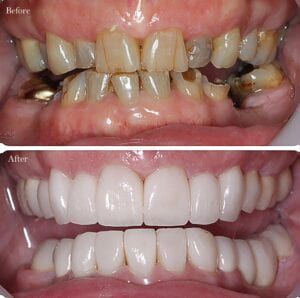Are things about your smile that you wish you could change? If so, then you may want to try getting a dental crown. Dental crowns are tooth-shaped caps that fit over the top of an existing tooth. They have a variety of uses and can completely make over your entire smile.
Normally, it takes two dental appointments to place a dental crown since most crowns need to be fabricated in a dental lab. However, at your local dental office we can place dental crowns in only one dental appointment. This means that you can have your smile makeover completed in only one day. This also means that you will not need to wear a temporary crown, which can be uncomfortable at times. The reason we can offer this is because of our in-office milling machine that allows us to fabricate your custom crown while you wait.
To place a dental crown, your dentist will first need to prepare the tooth. This is generally done with the use of dental anesthetic so that your mouth will be numb during the procedure. The first step of preparing a tooth for a dental crown is to remove any decayed or damaged tissue. Next, the remaining healthy tissue will be properly shaped so that it can accommodate the placement of a dental crown without changing your bite. Once the tooth has been prepared, an oral scan will be taken of your mouth. This formation will be sent to our in-office milling machine so that your custom dental crown can be fabricated according to the specifications provided. It generally takes about an hour or so to fabricate your dental crown and then it will be permanently cemented in your mouth.
As you can see, dental crowns can easily be placed during one dental appointment. At this point you may be wondering why you should get a dental crown. Well, here are five different things that dental crowns can fix:
Decayed teeth

One of the most common problems dental crowns are used to fix are decayed teeth. However, dental crowns are only used to fix decayed teeth when a significant portion of the tooth natural structure has been affected. Dental crowns are also used after a root canal in order to preserve the natural tooth structure and prevent the need for tooth extraction. In both cases, the decayed tissue is removed before a crown is placed to provide additional stability and protection for the remaining tooth structure.
Damaged Teeth
Another possibly used for dental crowns is to fix damaged teeth. Both healthy teeth and those affected by decay are susceptible to becoming damaged, although damage is more likely to occur in decayed teeth. When a tooth chips or cracks and the damage is deep enough to reach the dentin layer, then a dental crown can be used to restore the tooth. Placing a dental crown over a damaged tooth helps to protect the underlying tooth structure and prevents bacteria from entering the inside of the tooth.
Imperfect Teeth
Teeth can become stained for a variety of reasons. While teeth whitening procedures are generally used to remove stains, there are certain types of stains that cannot be removed. In these cases, the best course of action is to restore the stained tooth or teeth with one or more dental crowns. This is also ideal when an old metal filling has caused the tooth to take on a greyish or bluish appearance.

Besides color, there are a variety of characteristics that can affect the overall look of your teeth. In some cases, dental crowns can be used to make cosmetic changes to the look of your teeth. For example, dental crowns can be used to fix teeth that are oddly shaped, unevenly sized, too small, or improperly spaced.
An Uneven Bite
In some cases, dental crowns can even be used to make the bite more even. This is especially common in cases where the teeth are unevenly sized, which causes opposing teeth to meet one another unevenly. This can create a bite where certain teeth are more stressed than others. Therefore correcting the size of the teeth with dental crowns makes the entire bite more even overall.
Tooth Sensitivity
Over time, the protective enamel layer can wear down. Although this is a natural process, it can be progressed by things like teeth grinding or consuming a lot of acidic foods that erode the enamel. In cases where the enamel is really thin, this can cause the teeth to become sensitive to hot, cold, and sweet. Placing a dental crown over sensitive teeth is ideal because the crown acts as a barrier between the tooth and the stimuli causing sensitivity.



